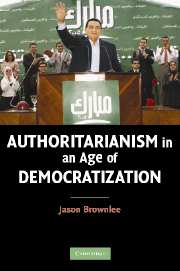Book contents
- Frontmatter
- Contents
- List of Figures and Tables
- Abbreviations and Acronyms
- Acknowledgments
- Introduction: Authoritarianism in an Age of Democratization
- 1 The Political Origins of Durable Authoritarianism
- 2 The Inception of Ruling Parties
- 3 Institutional Legacies and Coalitional Tensions
- 4 Ruling Parties and Regime Persistence
- 5 Elite Defections and Electoral Defeat
- 6 Confrontation and Democratization
- 7 Conclusions
- References
- Index
3 - Institutional Legacies and Coalitional Tensions
Published online by Cambridge University Press: 05 June 2012
- Frontmatter
- Contents
- List of Figures and Tables
- Abbreviations and Acronyms
- Acknowledgments
- Introduction: Authoritarianism in an Age of Democratization
- 1 The Political Origins of Durable Authoritarianism
- 2 The Inception of Ruling Parties
- 3 Institutional Legacies and Coalitional Tensions
- 4 Ruling Parties and Regime Persistence
- 5 Elite Defections and Electoral Defeat
- 6 Confrontation and Democratization
- 7 Conclusions
- References
- Index
Summary
When the dust of early elite conflict had settled, elites in Egypt, Malaysia, Iran, and the Philippines were all using parties of some form, yet only regimes in Egypt and Malaysia would maintain those parties through the end of the twentieth century. Institutional variation was both the product of earlier events and the prelude to later contrasts between durable authoritarianism in Egypt and Malaysia and opportunities for democratization in Iran and the Philippines. This chapter bridges the previous chapter's analysis of regime formation and the subsequent chapters' accounts of recent political development in Egypt, Iran, Malaysia, and the Philippines. Continuing the format of the prior chapter, the following narratives extend from the aftermath of early elite conflict through the maintenance or dismantlement of parties. The case studies also cover the inauguration of limited multiparty elections in all four regimes, elections in which incumbent elites dominated and opposition movements were severely disadvantaged. Prima facie similarities notwithstanding, the regimes reached electoral supremacy by means of widely divergent paths: On one track, ruling parties accommodated otherwise disparate elite factions; on the other, leaders deactivated parties to neutralize dissenters and tighten their hold on power.
These variations in behavior and their long-term consequences at the national level emerged from similar interests and dissimilar contexts. As demonstrated in the comparison of regime origins, elites seek to maintain their influence as national-level agenda setters. Additionally, they work to exercise and, when possible, expand that influence.
- Type
- Chapter
- Information
- Authoritarianism in an Age of Democratization , pp. 82 - 121Publisher: Cambridge University PressPrint publication year: 2007



